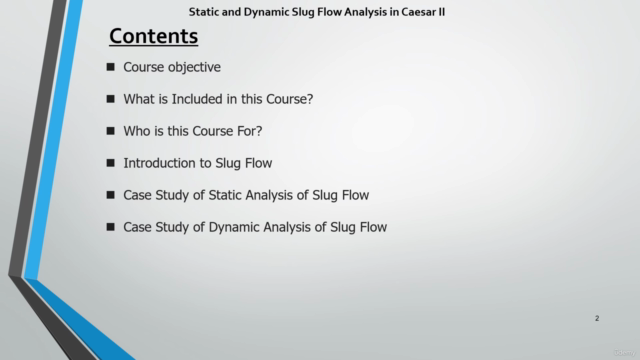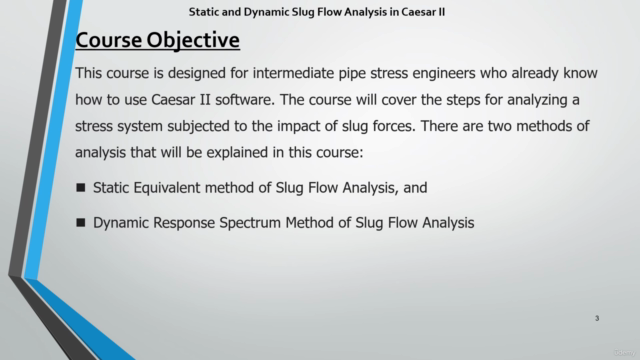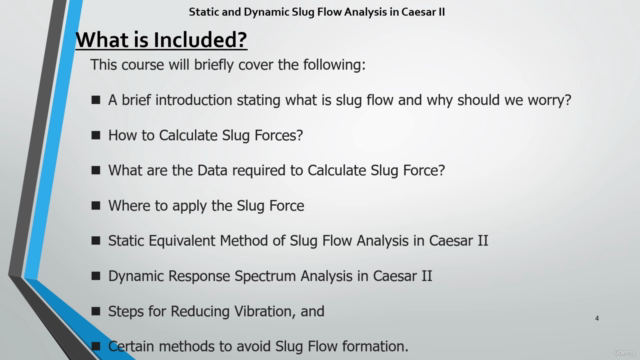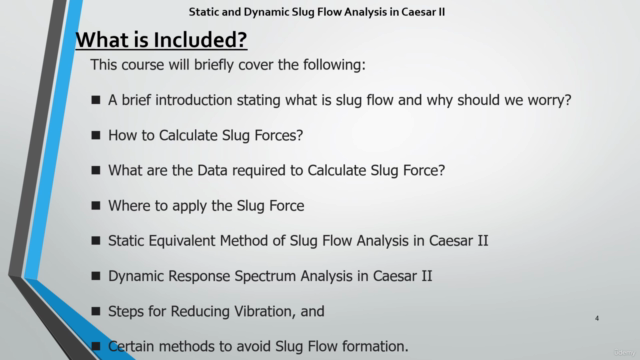Static and Dynamic Analysis of Slug Flow in Caesar II

Why take this course?
🚀 Course Title: Static and Dynamic Analysis of Slug Flow in Caesar II
🧐 Headline: Master the Intricacies of Slug Flow Analysis with Caesar II!
🎉 Course Description:
Piping systems are the lifelines of numerous industries, ensuring the smooth transit of fluids across different points. However, when it comes to slug flow – a common occurrence in such systems – the game changes. Slug flow, characterized by the alternating movement of gas and liquid slugs, can introduce complex dynamics that challenge even the most seasoned engineers.
In this comprehensive course, "Static and Dynamic Analysis of Slug Flow in Caesar II," you'll dive deep into the world of piping analysis and learn how to leverage this powerful software to tackle the unique challenges presented by slug flow. Whether you're a novice or an experienced professional looking to sharpen your skills, this course will equip you with the knowledge and expertise required to perform both static and dynamic analyses effectively.
Why Take This Course?
-
Understanding Slug Flow: Learn the fundamentals of slug flow, its influence on piping systems, and the key factors that dictate its behavior.
-
Static Analysis Mastery: Gain insights into setting up static analyses in Caesar II, from defining geometry and boundary conditions to understanding material properties and interpreting load cases.
-
Dynamic Analysis Skills: Discover how to perform dynamic analyses to predict the behavior of piping systems under time-dependent loads and events like slug flow.
-
Real-World Applications: Apply your newfound skills to real-world scenarios, ensuring the integrity and safety of piping systems in various industries.
Course Outline:
-
📏 Introduction to Slug Flow
- Understanding slug flow dynamics and its impact on piping systems.
-
🛠️ Static Analysis with Caesar II
- Defining pipe geometry, supports, and restraints.
- Inputting material properties for accurate static load predictions.
- Setting up and interpreting different load cases to identify failure points.
-
📊 Material Properties and Geometry
- Learning how to input and utilize material data to predict behavior under static loads.
-
🔁 Load Cases for Static Analysis
- Creating load cases that reflect the system's steady-state conditions and potential failure points.
-
⏱️ Dynamic Analysis Capabilities
- Exploring dynamic analysis features in Caesar II for evaluating transient events such as slug flow.
-
🌊 Dynamic Loadings in Slug Flow
- Specifying dynamic loadings by considering slug frequency, amplitude, and interaction with the piping system.
-
📈 Analyzing Results
- Utilizing Caesar II's output reports for static and dynamic analyses to optimize design solutions.
By the end of this course, you'll have a robust understanding of both the static and dynamic aspects of slug flow analysis using Caesar II. You'll be able to confidently assess piping systems under varying conditions and contribute significantly to the safety and efficiency of industrial operations. 🏭🚀
Join us on this analytical journey and become a proficient Caesar II user, ready to tackle the challenges of slug flow in today's demanding industries! 🎓✨
Course Gallery




Loading charts...